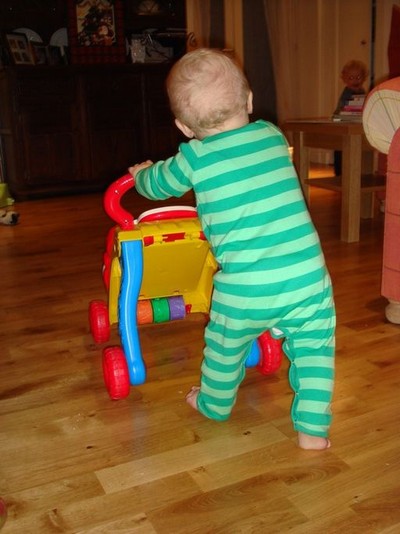
If you are a child care provider working with infants, you may be amazed by how quickly the babies in your child care program grow. By the time they are 1 year old, babies have almost tripled their birth weight. They learn to control their head, arms, hands, legs and feet, eventually start crawling and may even take a few first steps.
Child care providers help infants develop physically. Providing nutritious foods, encouraging their growing motor skills and providing safe places for babies to explore are wonderful ways your child care program can support physical development. The following lists describe some common physical and motor skills that most babies achieve at different ages. This list is just a guideline. Every baby is an individual and develops on her own schedule.
By 4 months, most babies…
- weigh about 10-18 pounds
- are about 23-27 inches long
- sleep about 14-17 hours daily
- can lift their head and chest when lying on stomach
- hold both eyes in a fixed position
- follow a moving object or person with their eyes
- grab and hold onto a rattle or your finger
- wiggle and kick with arms and legs
- roll from stomach to back
- sit up, but only with support
By 8 months, most babies…
- weigh about 14-23 pounds
- are about 25-30 inches long
- begin getting their first teeth
- start to have hair growth covering the head
- have true eye color established
- tend to drool a lot
- develop a rhythm for feeding, eliminating, sleeping and being awake
- reach for the cup or spoon when being fed
- close their mouths firmly or turn their heads away when no longer hungry
- drink from a cup with help
- eat some finely chopped, solid foods
- may sleep as much as 11-13 hours at night (although this varies greatly)
- need two or three naps during the day
- roll from back to stomach and stomach to back
- sit alone without support
- raise up on arms and knees into crawling position
- rock back and forth on hands and knees, but may or may not move forward
- like to mouth and chew on objects
- use the finger and thumb to pick up objects
- transfer objects from one hand to the other
 By 12 months, most babies…
By 12 months, most babies…
- weigh about 17-27 pounds
- are about 27-32 inches long
- start to refuse a bottle or wean themselves from the breast during the day
- need at least three meals a day, with two snacks in between to meet their nutritional needs
- enjoy drinking from a cup and may start using a cup by themselves
- eat some finger foods
- sleep 11-13 hours at night but may still wake up occasionally during the night
- still take naps
- might stop taking a morning nap or might continue both morning and afternoon naps
- still explore everything by mouth
- enjoy opening and closing cabinet doors
- crawl well and can move very quickly by crawling
- pull themselves to a standing position
- stand alone and walk while holding on to furniture for support
- might take a few steps alone
Tips to Nurture Babies’ Physical Development
- Create safe play areas for babies. Babies need chances to explore by handling and mouthing objects, reaching, rolling and crawling. Make sure your child care space is safe. Store toxic substances such as cleaning products and medicines in a locked cabinet out of babies’ reach. Put safety latches on cabinets and covers on electrical outlets to keep curious babies out. Cover sharp corners of tables and shelves that babies might bump into.
- Make sure cribs are safe. Lower crib mattresses so older infants can’t fall out. Remove mobiles as soon as babies can sit up on their own. Make sure cribs are away from windows, cords, and other furniture.
- Respect each baby’s natural schedule. Young babies in child care should not be expected to stay on the same schedule. Most babies will settle into a regular routine for eating, sleeping and soiling their diapers, but the schedule will vary depending on the baby. Some babies need to eat more frequently than others. Some will sleep longer and more regularly than others. Know all of the babies in your child care program well and adjust the schedule to meet their individual needs.
- Encourage older infants to feed themselves. Eating with fingers or a spoon is a great chance for babies to practice controlling their hands and fingers. Be patient. Learning this skill takes lots of practice and may be messy at first.
- Give babies freedom to move around. Place young infants on their backs so they can kick, wiggle and look around. Give older babies the time and space to crawl, pull up and walk while holding on to furniture. Spending too much time in a walker, play pen or infant swing may inhibit the development of these important skills.
For More Information
To learn more about how child care providers can support infants’ development, take a look at the following eXtension Alliance for Better Child Care articles:
- Creating Safe and Appropriate Napping Areas in Child Care
- Feeding Solid Foods to Infants in Child Care
- Giving Infants Time on the Floor
- Talking with Babies in Child Care
- What Child Care Providers Can Expect in Infants’ Social and Emotional Development
- What Child Care Providers Can Expect in Infants’ Thinking and Language Development
